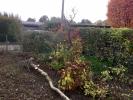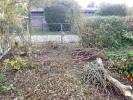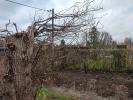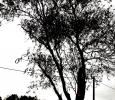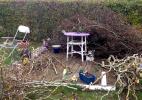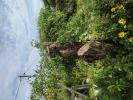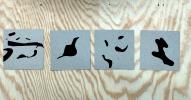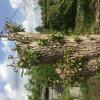Wednesday 31 August
from 14:00 CEST until 12:00 noon on Thursday 1 September
Christina Ertl-Shirley
Salix matsudana Tortuosa
22 hours with the recalcitrant corkscrew willow A plot of land near Berlin on which stands a half-felled corkscrew willow (Salix matsudana Tortuosa). The tree, which was many meters tall before being cut back and often attracted attention with its "curly" branches, was planted in 1974 and had to be cut down to a 90cm trunk two years ago due to city regulations. Passing walkers always mourn around this beautiful tree, but are also amused by its unruliness: The remaining trunk sprouts again and again and countless red-green shoots grow out of it in the most diverse variations, which then must be trimmed again immediately so that no real branches form. The trimmed tree seems more active than ever and has become a favorite habitat for insects, birds and tree fungi and perhaps other species. Its sawed-off jagged branches, which have been converted to fences, are also beginning to sprout regularly. For Radio Art Zone, this corkscrew willow becomes a sound producer itself for 22 hours, as I sonify its biological processes, and capture the sounds of its inhabitants and environment. In this soundscape, facts, anecdotes, songs, poems, dreams, and conversations around the tree interweave and become a multidimensional narrative. For this I use material from archives, realize my own willow compositions and invite musicians, people out for a walk, poets and tree experts to stay next to the tree trunk and listen to what they have to share with me inspired by the recalcitrant corkscrew willow.
THANKS TO
the colleagues and friends who have shared their thoughts, poetry, and recordings; who allowed me to interweave them with my corkscrew willow sonic associations:
(The times in brackets are the start times of their contributions in the 22 hour piece)
Katharina Ludwig „Trauerweideda“ (1hour 20min)
Mauro Pandolfino „transvait“ (2hours 17min)
Andrea Ermke „Totes Holz“ (2hours 45min)
Mauro Pandolfino „Tiresia“ (5hours 21min)
Adam Asnan (gong), Bryan Eubanks (seeds) „ Gong / Seeds“ (6hours 43min)
Derek Shirley (7hours 35min)
EdelWe (Paul Lubitz und Sascha Wohlfahrt) „Beat Noir1“ (11hours 50min)
Mauro Pandolfino „Prelude“ (14hours 37min)
Rexe Kenn „Wohin“ (15hours 00Min)
EdelWe (Paul Lubitz & Sascha Wohlfahrt) „Beat Noir 16“ (16Std 09Min)
Johnny Chang for Johnny Chang & Christina Ertl-Shirley „Bushwalk in Berlin-Whangaparaoa“ (17hours 45min)
Anaïs Tuerlinckx „“Souvenirs éphémères pour bois trouvés le long de cordes flottants” (18hours 55min)
Derek Shirley (20hours 55min)
Special thanks to Julia Saragosa as speaker of the sound story „Combed, throbbed and loving mulm“. ( 6 Std 58 Min)
I would also like to thank everyone whose voices, thoughts and sounds inspired and found their way into this program: Abigail Shirley, Mauro Pandolfino, Sea Oba Smith, Lena Mahler, the birds, insects, the wonderful carpenters bee, the gardeners in the garden colony and their tools, the passing walkers and of course the one and only corkscrew willow.
22 Stunden mit der widerspenstigen Korkenzieherweide Ein Grundstück in der Nähe von Berlin auf dem eine halb gefällte Korkenzieherweide (Salix matsudana Tortuosa) steht. Der vor der Kürzung viele Meter hohe Baum, der mit seinen „gelockten“ Ästen oft Aufmerksam auf sich zog, wurde 1974 gepflanzt und musste vor zwei Jahren aufgrund von Vorschriften der Stadt bis auf einen 90cm hohen Stamm gekappt werden. Vorbeigehende Spaziergänger*innen trauern immer wieder um diesen ehemals schönen Baum, aber amüsieren sich auch über seine Widerspenstigkeit: Der übrig geblieben Stamm, treibt er immer wieder weiter aus und es wachsen unzählige rot-grüne Triebe in verschiedensten Varianten aus ihm heraus, die dann wieder umgehend gestutzt werden müssen, damit sich keine wirklichen Äste bilden. Der ges tutzte Baum scheint aktiver denn je und hat sich zu einem beliebten Lebensraum für Insekten, Vögel und Baumpilze und vielleicht auch andere Artenentwickelt. Seine abgesägten gezackten Äste, die zu Zäunen umfunktioniert wurden, beginnen auch regelmäßig zu sprießen. Für Radio Art Zone wird diese Korkenzieherweide 22 Stunden selber zur Klangerzeugerin, indem ich ihre biologischen Prozesse sonifiziere, und ich die Geräusche seiner Bewohner und Umgebung einfange. In diesem Soundscape verweben sich Fakten, Anekdoten, Songs, Gedichte, Träume und Gespräche rundum den Baum und werden zu einer mehrdimensionalen Erzählung. Dazu verwende ich sowohl Material aus Archiven, realisiere eigene Weiden-Kompositionen und lade Musiker*innen, Spaziergänger*innen, Dichter*innen und Baumexpert*innen dazu ein, neben dem Baumstamm zu verweilen und höre zu, was sie mir, inspiriert von der widerpenstigen Korkenzieherweide, mitzuteilen haben.
DANKE
an die Kolleg*innen und Freund*nnen, die ihre Gedanken, Gedichte und ihre Kompositionen und Aufnahmen mit mir geteilt haben und mir erlaubten, sie mit meinen Korkenzieherweiden-Klangassoziationen zu verweben:
(Die Zeiten in Klammern sind die Anfangszeiten ihrer Beiträge in dem 22-stündigen Stück)
Katharina Ludwig „Trauerweideda“ (1Std 20min)
Mauro Pandolfino „transvait“ (2Std 17min)
Andrea Ermke „Totes Holz“ (2Std 45min)
Mauro Pandolfino „Tiresia“ (5Std 21min)
Adam Asnan (gong), Bryan Eubanks (seeds) „ Gong / Seeds“ (6Std 43min)
Derek Shirley (7Std 35min)
EdelWe (Paul Lubitz und Sascha Wohlfahrt) „Beat Noir1“ (11Std 50min)
Mauro Pandolfino „Prelude“ (14Std 37min)
Rexe Kenn „Wohin“ (15Std 00min)
EdelWe (Paul Lubitz & Sascha Wohlfahrt) „Beat Noir 16“ (16Std 09Min)
Johnny Chang for Johnny Chang & Christina Ertl-Shirley „Bushwalk in Berlin-Whangaparaoa“ (17Std 45min)
Anaïs Tuerlinckx „“Souvenirs éphémères pour bois trouvés le long de cordes flottants” (18Std 55min)
Derek Shirley (20Std 55min)
Besonderer Dank gilt Julia Saragosa als Sprecherin der Klanggeschichte "Gekämmt, gepocht und Mulm liebend". ( 6 Std 58 Min)
Ich möchte auch all jenen danken, deren Stimmen, Gedanken und Klänge den Weg in dieses Stück gefunden und es inspiriert haben: Abigail Shirley, Mauro Pandolfino, Sea Oba Smith, Lena Mahler, den Vögeln, Insekten, der wunderbaren Holzbiene, den Gärtner*innen in der Gartenkolonie und ihren Werkzeugen, den vorbeikommenden Spaziergänger*innen und natürlich der einzigartigen Korkenzieherweide.
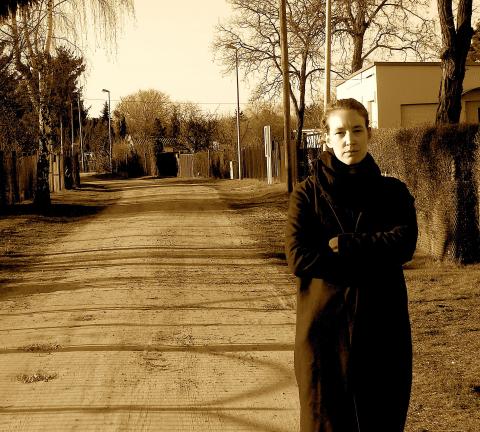
Christina Ertl-Shirley creates audio*visual narratives in the form of sound installations, radio plays, drawings, radio features, short stories, and compositions (based on field recordings and analog synthesizers). She sees her works as transmedia explorations with experimental approaches to the sharing of knowledge. She is particularly concerned with the interweaving of nature, art, and technology, immersing herself in the respective microcosms, such as the world of the animal "paper nautilus", the cultural history of the elevator, the environment of wooden beetles in the Berlin forest or the discipline of moss research. The starting point for her work is traveling these niches through scientific, historical, and subjective material. She draws on the suggestive possibilities of these elements and comments on them through her own acoustic, visual and haptic investigations, realizing artistic narratives from them.
Christina Ertl-Shirley kreiert audio*visuelle Erzählungen in Form vonKlanginstallationen, Hörspielen, Zeichnungen, Radiofeatures, Kurzgeschichten undKompositionen (auf der Basis von Fieldrecordings und analogen Synthesizern). Siesieht ihre Arbeiten alstransmediale Forschungen mit experimentellen Ansätzen zurWissensvermittlung. Dabei beschäftigt sie sich besonders mit der Verschränkungvon Natur, Kunst und Technik und taucht dazu in die jeweiligen Mikrokosmen ein,wie zum Beispiel in die Welt des Tieres„Papiernautilus“, die Kulturgeschichte desFahrstuhls, die Umgebung von Holzkäfern im Berliner Forst oder die Disziplin der Moosforschung. Ausgangspunkt für ihre Arbeiten ist das Bereisen dieser Nischendurch wissenschaftliches, historisches und subjektives Material. Sie schöpft aus densuggestiven Möglichkeiten dieser Elemente und kommentiert sie durch eigeneakustische, visuelle und haptische Untersuchungen und realisiert darauskünstlerische Narrationen.
